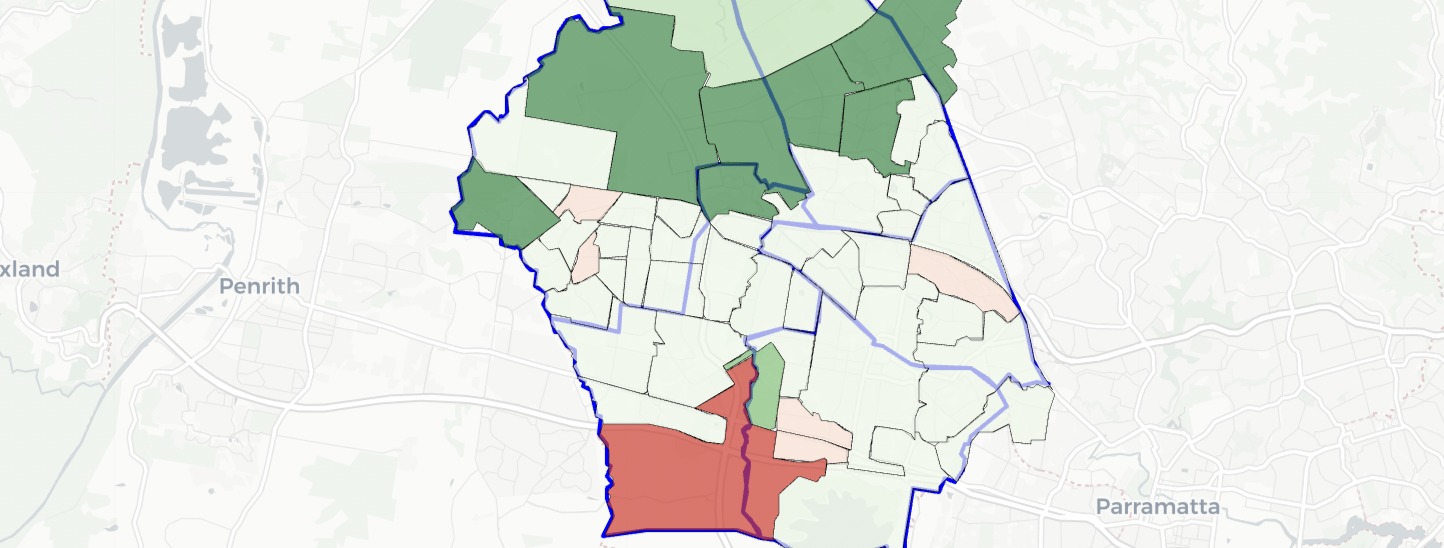This is a follow-up to Wednesday’s post about voter enrolment numbers increasing in Camden Council, this time looking at the equivalent growth taking place in the north-west of Sydney, primarily in the north-eastern corner of the City of Blacktown.
This growth looks less dramatic as a proportion of Blacktown’s total population, because it was a much larger council to begin with. Blacktown is the most populous council in New South Wales, while Camden ranks quite far down the list (and particularly did before the last decade of growth). But it remains quite substantial and has forced redistributions of ward boundaries before every election since at least 2008.
This map shows the changes in ward boundaries since 2004. It isn’t as clear-cut as the Camden map, but Ward 1 is definitely shrinking over time, most dramatically in the most recent redistribution.
The first ward covers Kellyville Ridge, Parklea, and parts of Riverstone and Schofields (which were entirely contained in the ward until the most recent redistribution). It’s right across the council border from Rouse Hill and Kellyville, in the Hills council area.
This chart shows the enrolment for each ward since 2007. Sudden changes reflect redistributions implemented in 2008, 2012, 2016 and 2020.
Ward 1 has always been the most populous in terms of voters. Even if electoral boundaries were redrawn to make it less populous than other Blacktown wards, it had always overtaken them before the NSWEC implemented the redistribution on the roll data.
Ward 1 has been steadily growing for the last 14 years, even if other wards had largely stabilised for years at a time. Over the 2016-2020 period, three of the wards were stable while Wards 1 and 5 shot ahead, but Ward 1 was coming off a higher base than Ward 5.
The most recent redistribution had little impact on Wards 2 and 5, while it increased numbers in Wards 3 and 4 and shrunk Ward 1, but by the time the redistribution was implemented Ward 1 was already 16% bigger than Ward 3.
Since that redistribution, the three least populous wards have experienced little or no growth, while Wards 1 and 5 have shot further ahead. Ward 1 is new 24% more populous than Ward 3, and Ward 5 is 15% ahead.
While the council may have ensured that wards fit within the population numbers according to the law, they’ve done it in such a way that wards quickly fall out of equality, rather than drawing the faster-growing wards with a smaller population. I estimate that the new Ward 1 was 9% larger than the smallest ward based on the May 2019 data used to draw the wards in the first place. They did the absolute minimum necessary to meet the legal criteria.
You can see how the new ward boundaries would have applied to enrolment numbers over the last 14 years in this next chart:
Ward 1 was the least populous in 2007, overtaking Ward 5 in 2011. It has been the most populous fifth of the council since 2017.
This next chart shows the population per square KM for each CCD or SA1 at the time of the last three elections, and as of last month.
While the whole council has increased in population, that increase is was strongest in the north-east, which can also be seen on this next map, showing the increase per suburb over the last nine years:
I’ll be back on Monday with another post looking at data on redistributions for a number of other large councils.




Certainly one to watch with interest with the growth of new suburbs along Windsor Road such Grantham Farm. A lot of the newer areas are more middle class and increasingly a spill over of the Hills District. There is a rapidly growing South Asian community. These suburbs are on the other side of Sydney social divide and the Latte line goes through Blacktown LGA now.
@Nimalan
I’ve lived on both sides of (Old) Windsor Road, and your description of the northern half of Blacktown LGA as a “spillover” of the Hills District nails it. I’ve described it as “Hills V2.0”.
@ Nicholas, thanks for sharing your first hand insights of this area. I have been interested in this area after reading an interesting article in the lead up to the 2004 election as the socioeconomic fault line of Sydney goes through Blacktown LGA. It was said in the article that Vardys Road is an important social divide in the LGA (like the Monash Divide or Dingley Bypass in SE Melbourne) between middle class Kings Langley, Glenwood etc and the working class suburbs such as Lalor Park. At the time suburbs such as The Ponds did not exist and the South Asian immigrant population would have been significantly smaller.
https://www.crikey.com.au/2004/07/28/greenway-to-heaven-and-a-religious-wedge/
If not Vardys rd then definitely the M2
One side of Vardys Road is a suburb in the top 10%. The other side is a suburb in the bottom 10%. It is one of the most striking examples of socioeconomic contrast between two adjacent suburbs.
Between Sunnyholt Road and Eastern Creek, it’s a bit fuzzier, it’s more of a smooth gradient. West of Eastern Creek, it’s clearly the southern boundary of Colebee / Marsden Park / Shanes Park, with the exception of Ropes Crossing. Although I guess Bungarribee, Minchinbury, and Woodcroft are also exceptions! Western Sydney is such a patchwork.
Sunnyholt Road all the way west to the Penrith council boundary is probably the most crucial battleground at the next election.
Comments are closed.